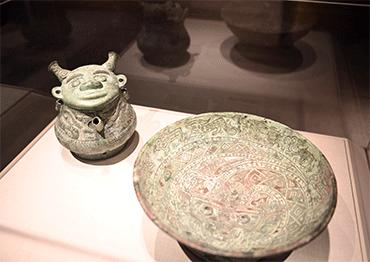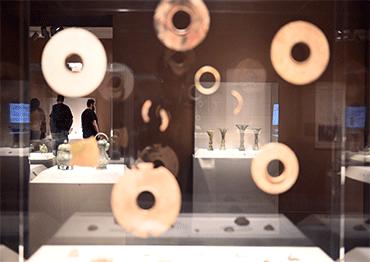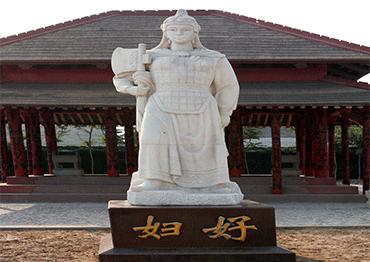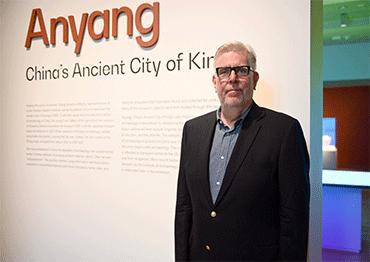s a part of events to celebrate the 100th anniversary of the National Museum of Asian Arts (NMAA) in Washington, DC, an exhibition presenting the history of Anyang, an ancient Chinese capital with more than 3,000 years of history, opened on February 25, 2023.
Titled “Anyang: China’s Ancient City of Kings,” the exhibition features over 200 artifacts from the NMAA’s permanent collections, “including jade ornaments, ceremonial weapons, ritual bronze vessels, bells and chariot fittings,” according to the NMAA website. The exhibition runs through April 28, 2024.
Located in what is today Henan Province, Anyang served as the capital of the Shang Dynasty, a Bronze Age civilization dating from 1600-1046 BCE. It was in Anyang that the oracle bones with inscriptions, the earliest Chinese writings, were found and one of Chinese earliest archaeological works was started.
In an interview with China News Service, J. Keith Wilson, curator of the exhibition and curator of ancient Chinese art at the NMAA, explained how the event can not only help visitors understand ancient China but also early exchanges between China and the US, and how it can further promote cultural communication between the two countries.
China News Service: What inspired your interest in the field of ancient Chinese studies?
J. Keith Wilson: I first started studying contemporary China back in the 1970s when I was an undergraduate at college.
At that time, China was very much in the news. The Cultural Revolution (1966-76) was just ending and a new phase was beginning. And I was really curious about China. Most Americans had not really had a chance to study it and visit China.
So it began with an interest in contemporary China. But once I started studying Chinese history, it was kind of like entering a time machine. You go back further and further and further as more and more interesting things emerge. Ultimately, I found the early Bronze Age, essentially the period of the Anyang exhibition, to be what interested me the most.
CNS: Why did you choose Anyang to be part of the centennial celebration of the museum?
JKW: While thinking about the National Museum of Asian Art’s centennial (back then known as the Freer Gallery of Art), I wanted to do a show that had a historical resonance and then referenced those 100 years of history. I was reminded that the museum was involved as a sponsor for the early excavations at Anyang. In fact, the museum financially supported two seasons of Academia Sinica’s excavation work at Anyang in 1929 [Academia Sinica is the national academic institution founded by the Kuomintang government in 1928. It moved to Taiwan with the Kuomintang government in 1949]. I thought from that historical point of view, connecting our history with Chinese history and with the birth of archaeology, was a resonating story that many Americans were unaware of. I think perhaps many Chinese students were also unaware that the museum played a small role in the birth of modern archaeology in China.
Therefore, Anyang seemed like a logical subject to explore, which also coincides with a great strength in our collection over the decades, not from the site itself, but from the global international art market. The museum and collectors and supporters have been finding material that resembles the kinds of pieces that archaeologists were finding in Anyang. Our permanent collection now includes these great objects that help tell an archaeological story.
CNS: How does the show tell the story to the modern audience in the US?
JKW: I think [by] helping Americans understand archaeology’s contribution in cultivating our knowledge of ancient Chinese culture, just like ancient cultures everywhere.
Before archaeology, our understanding was based on myths, legends and transmitted histories, but there were always important and serious questions about how much of that was true. I think the great result of archaeology and of this particular use of archaeology in the Anyang exhibition is to show the contribution that archaeology has made, by as you say, reviewing essentially the birthplace of recorded history, since currently in our understanding, Anyang has provided the earliest datable Chinese writing. So we knew from the start that for our exhibition, ancient Chinese inscriptions would be a major part of the show.
Although our collection of oracle bones is very small, we can tell that important story through digital tools using some examples that are in the Academia Sinica collection in Taiwan. At the same time, we have a rich collection of inscribed bronzes, and we wanted to foreground those inscriptions and help our visitors understand what those inscriptions mean. This was especially important to my collaborator, Kyle Steinke, who served as research curator for the project.
CNS: You have been a curator for this museum for almost 17 years. From your perspective, how has the NMAA introduced Chinese arts and culture over the years?
JKW: It’s important for us to tell the aesthetic story to help people appreciate really the beauty of Chinese art on the one hand. But I’m a person who is very interested in technology and production processes. The Anyang example is typical. I’d like to also help our visitors understand the process that lies behind the production of these objects and what that process tells us about culture. The complexity of casting bronze is one of the core subjects of the exhibition. We even recreated a casting assembly to help our visitors understand the Chinese casting process that involves ceramic piece-molds and ceramic models, so helping our visitors also understand not just the beauty, but the technology that lies behind the objects.
Last but not least is the cultural story: to understand why these objects were made, how they were used, why they were important to their own people, their own time. I hope through visiting shows like Anyang, American visitors gain a clear understanding of kingship, ancestor worship, mortuary customs and the cosmological beliefs of the Shang people, telling those stories through the interpretation of the objects on display.
CNS: What sparks the curiosity of your visitors?
JKW: I’ve been amazed by the great interest in oracle bones, because this reflects a completely alien practice and a very unique approach to communication with the ancestors and with the spirits. A lot of people have been very, very curious and interested in that practice.
I’ve been particularly interested in the reaction of students, especially students that are in Chinese language immersion programs. There are many in the [Washington] DC area. And a number of their teachers are bringing the students to show them the origins of Chinese writing through things like the inscriptions on the oracle bones.
I think there is an interest there that was surprising to me, but a welcome kind of outcome.
We chose a really great example for the touch screen in the exhibition. Again, since our oracle bones are not particularly distinguished, we used the 3D model of one of the important corpus of bones excavated from the so-called Oracle Bone Archive, YH 127 [which is the most famous oracle bone pit] in the Anyang palace site that was found in 1936. The shell that we chose to show in the gallery actually has an inscription about Fu Hao, the woman who was buried in a tomb that was excavated in 1976, the only intact royal burial found at the Anyang site over the past 100 years.
In the exhibition, there is a powerful story that connects an oracle bone with the name of a historical queen who lived and reigned at the site, to the archaeological discovery of her tomb. This connection confirms the existence of a real person whose life is partially known through the oracle bones, and whose death is well documented through the contents of her tomb.
CNS: What was the most challenging part during your organization of the show?
JKW: When I first thought about doing this exhibition and spoke with colleagues in the field, they all assumed that I would be borrowing the objects from China. It’s always easier if you’re doing an archaeology show to borrow specific discoveries that have been made recently. They’re exciting. You can talk about the discovery context, and the excavation of the material. Everyone was really surprised when I said, no, we’re not borrowing anything. We’re telling the story through the permanent collection. The challenge really was how to tell essentially an archaeology story through an heirloom collection that was assembled without much context behind each object.
In essence, how do we contextualize objects that came without any provenance? Early on, Kyle Steinke and I identified the important role that digital tools would play in telling the archaeology story. As you go through the exhibition, you can really think of it as two parallel experiences where you’re looking at the art collection objects that tell some part of the story, that tell the aesthetic story, the technical story and the graphic story.
But what they can’t tell is the progress of archaeology at the site and the development of archaeology in China over the last 100 years. For that, we really needed to rely on photographs, films, and interactive 3D experiences to help bring those two worlds – those two disciplines – back together in the show, trying to make sure that we got the balance correct, the archaeology and art, the digital and the actual. That was a challenge from the very beginning. I hope that we got that balance right and that we are telling the story effectively, both from the archaeological point of view and from the art historical point of view.
CNS: Are you already planning the next exhibition?
JKW: Currently, a small monographic show is on view right next to the Anyang show on a piece in the Freer collection, a so-called coromandel screen or kuancai screen. These were made essentially during the Qing Dynasty (1644-1911) for local Chinese consumption, and in other cases, made for export. We have a great example in the Freer collection that has not been on view for many, many years due to its condition. After a multi-year conservation project on the screen, it will be revealed for the first time following this conservation work very soon. So that is our next Chinese exhibition to open.
CNS: Can you share any recent stories between you or the museum with your Chinese counterparts?
JKW: I was heartbroken when Covid came in 2020. We were supposed to be involved in our first significant loan to the Palace Museum in Beijing. I was delighted to be asked to be involved, to lend objects from the Sackler collection to a show at the Palace Museum that was attempting to chronicle the imperial collection of [Qing] Emperor Qianlong (reigned from 1736-1796), his bronzes.
This was meant to celebrate a republication of the Qianlong bronze catalogue that had been undertaken as a collaborative project with a New York sponsor. To unveil the publication project the Palace Museum wanted to have an exhibition, borrowing some of those objects that had once been in the Qianlong collection. Three objects in the Sackler were identified as having been in the imperial collection in the 18th century. We had prepared to lend the objects to China and we were all prepared to go for the opening of the exhibition when Covid struck, which really affected a lot of international programs. We’re only beginning to recover now. What I’m finding to be most successful is people-to-people exchanges without exchanges of objects. We will certainly be inviting some of our Chinese colleagues to speak at the Anyang symposium on March 7 and 8, 2024. I’m finding that those kinds of established exchange projects are the best way to proceed right now until everyone is really more comfortable with the exchange of objects in larger programs.
CNS: How will the National Museum of Asian Art promote communication between Chinese and American people?
JKW: I think at the museum, we found that our audiences are very curious about two large topics.
And within those large topics, there are many sub-themes that we can explore. One is archaeology, which is fortunately always in the news. There are all these remarkable discoveries that keep coming to light. So I think our audience is interested in ancient China through the lens of archaeology, which makes me happy. It gives me some guidance on the types of projects I should be developing to reach our audiences and enhance their understanding of ancient China.
But we’ve also found that Americans are very interested in the imperial institution, the emperors and empresses. We did a wonderful show a number of years ago on the empresses of the late Qing court. It was a very popular show, and important because the imperial institution was responsible for creating amazing objects in a range of media through the royal workshops.
I think this offered us another perspective to explore the art and culture of ancient China by examining court context, production and the objects that truly represent the later imperial era.

 Old Version
Old Version


